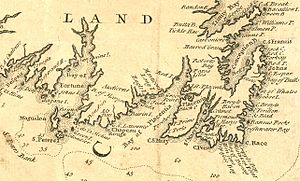| Newfoundland expedition | |||||||
|---|---|---|---|---|---|---|---|
| Part of Queen Anne's War | |||||||
 Extract of a 1744 map showing southeastern Newfoundland | |||||||
| |||||||
| Belligerents | |||||||
|
|
| ||||||
| Commanders and leaders | |||||||
|
|
| ||||||
| Strength | |||||||
| 9 ships | Unknown number of French colonists and militia | ||||||
| Casualties and losses | |||||||
| none |
51 merchantmen captured several merchantmen destroyed | ||||||
The Newfoundland expedition was a naval raiding expedition led by English Captain John Leake between August and October 1702 that targeted French colonial settlements on the North Atlantic island of Newfoundland and its satellite, Saint Pierre. The expedition occurred in the early days of Queen Anne's War, as the North American theater of the War of the Spanish Succession is sometimes known.
Leake's fleet descended on French settlements on the southern shore of Newfoundland, destroying fishing stages and other infrastructure. They captured fishing and trade ships, and destroyed most of the settlement at Saint Pierre. In a final flurry of activity before returning to England, Leake captured several ships from the French merchant convoy as it headed for Europe. More than 50 ships were taken in total, and six seasonal settlements were destroyed. The strongly fortified French base at Plaisance was not attacked.